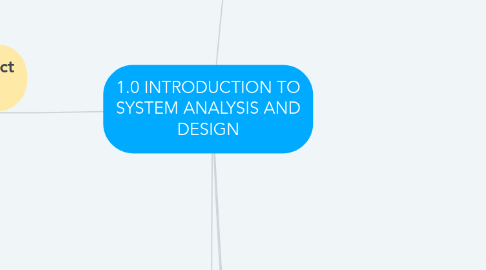
1. 1.2.5 Describe project management activities:
1.1. a. planning
1.1.1. Identifying all project tasks and estimating the completion time and cost of each.
1.2. b. scheduling
1.2.1. Involves the creation of a specific timetable, usually in the form of charts that show tasks, task dependencies, and critical tasks that might delay the project
1.3. c. monitoring
1.3.1. Requires guiding, supervising, and coordinating the project team’s workload.
1.4. d. reporting
1.4.1. Includes regular progress reports to management, users, and the project team itself.
2. 1.3 Understand Project Management
2.1. 1.3.1 Explain project planning, scheduling, monitoring, and reporting.
2.2. 1.3.2 Explain steps in project planning.
2.2.1. Step 1: Project Goals
2.2.2. Step 2: Project Deliverables
2.2.3. Step 3: Project Schedule
2.2.4. Step 4: Supporting Plans
2.3. 1.3.3 Describe work breakdown structures, task patterns, and critical path analysis.
2.3.1. A work breakdown structure must clearly identify each task and include an estimated duration.
2.3.2. Tasks in a work breakdown structure must be arranged in a logical sequence called a task pattern.
2.3.3. Is a series of tasks which, if delayed, would affect the completion date of the overall project
2.4. 1.3.4 Create a work breakdown structure.
2.5. 1.3.5 Explain techniques for estimating task completion times and costs.
2.6. 1.3.6 Explain leadership and project manager.
2.6.1. Good leadership is essential in building up an information system project.
2.6.2. In a systems project, the project manager, or project leader, usually is a senior systems analyst or an IT department manager if the project is large.
3. 1.2.4 Identify appropriate life cycle models based on given scenario
4. 1.1 Discuss Information System.
4.1. 1.1.1 Define information and information system.
4.1.1. Information : Is data that has been transformed into output that is valuable to users.
4.1.2. Information system : -Combines information technology, people and data to support business requirements. -Information System have 5 components which are hardware, software, data, processes and people.
4.2. 1.1.2 Describe information system components
4.2.1. Hardware
4.2.1.1. Is the physical layer of the information system
4.2.2. Software
4.2.2.1. System software
4.2.2.2. Application software
4.2.2.3. Enterprise applications
4.2.3. Data
4.2.3.1. Tables store data
4.2.3.2. Linked tables work together to supply data
4.2.4. Processes
4.2.4.1. Describe the tasks and business functions that users, managers, and IT staff members perform to achieve specific results
4.2.5. People
4.2.5.1. Stakeholders
4.2.5.2. Users, or end users
4.3. 1.1.3 Identify various types of information system.
4.3.1. Executives
4.3.1.1. Executive Information Systems
4.3.2. Senior Managers
4.3.2.1. Decision Support Systems
4.3.3. Middle Managers
4.3.3.1. Management Information Systems
4.3.4. Workers
4.3.4.1. Transaction Processing Systems
5. 1.2 Discuss system development approach.
5.1. 1.2.1 Explain system development method:
5.1.1. a. Structured Analysis
5.1.1.1. Is a traditional systems development technique that is time tested and easy to understand.
5.1.1.2. Uses a series of phases to plan, analyze, design, implement and support an IS.
5.1.2. b. Object Oriented Analysis
5.1.2.1. is a popular technical approach for analyzing, designing an application, system,
5.1.2.2. business by applying the object-oriented paradigm and visual modeling throughout the development life cycles to foster better stakeholder communication and product quality.
5.1.3. c. Agile/Adaptive Method
5.1.3.1. aim to provide new product or service development in a highly flexible and interactive manner.
5.2. 1.2.2 Explain System Development Life Cycle (SDLC) activities:
5.2.1. a. Planning
5.2.1.1. The purpose of this step is to find out the scope of the problem and determine solutions.
5.2.2. b. Analyze
5.2.2.1. Where businesses will work on the source of their problem or the need for a change.
5.2.3. c. Design
5.2.3.1. This is the step for end users to discuss and determine their specific business information needs for the proposed system.
5.2.4. d. Development
5.2.4.1. This work includes using a flow chart to ensure that the process of the system is properly organized.
5.2.5. e. Testing
5.2.5.1. Involves systems integration and system testing.
5.2.6. f. Implementation
5.2.6.1. This phase involves the actual installation of the newly-developed system.
5.2.7. g. Maintenance
5.2.7.1. Final phase involves maintenance and regular required updates.
5.3. 1.2.3 Describe various types of life cycle models such as:
5.3.1. a. Waterfall model
5.3.1.1. Represents the system in terms of data and the processes that objects that act upon that data.
5.3.2. b. Spiral Model
5.3.2.1. Stated that each iteration, or phase, of the model must have a specific goal that is accepted, rejected, or changed by the user, or client.
5.3.3. c. Iterative and incremental development
5.3.3.1. Allowing software developers to take advantage of what was learned during development of earlier parts or versions of the system
5.3.4. d. Agile Model
5.3.4.1. Methods attempt to develop a system incrementally, by building a series of prototypes and constantly adjusting them to user requirements
5.3.5. e. Prototyping model
5.3.5.1. Prototyping tests system concepts and provides an opportunity to examine input, output, and user interfaces before final decision are made.
5.3.6. f. Rapid Application Development (RAD)
5.3.6.1. Process allows users to examine a working model as early as possible, determine if it meets their need, and suggest necessary changes.
5.3.7. g. Joint Application Development (JAD)
5.3.7.1. Is a popular fact-finding technique that brings users into the development process as active participants.

